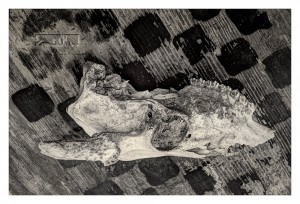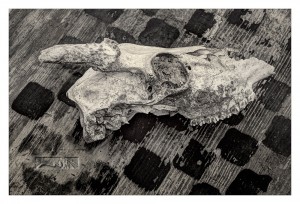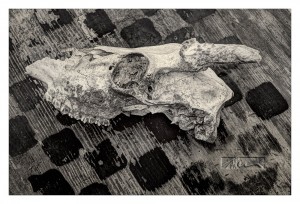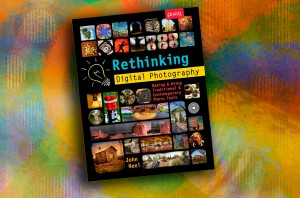Many image-makers living today have never experienced the image formed on the ground-glass of a large format camera.
Perhaps there is no real reason to know how an image is formed or to know that the image is captured upside down and flipped left to right. But in the past, photographers had little choice. I like to know how things work. I also like to know what I can do with that knowledge.
Yes. Even as you view the upright image on your iPhone or iPad, you are actually looking at an image that has been corrected to show you the scene with the correct orientation.
In fact, every camera produces images in reverse of what is seen in the monitor or viewfinder. In the days of film – especially with large format cameras, the photographer composed by viewing the image as upside down and reversed as it was projected through the ground-glass at the back of the camera. The camera viewfinder shows us an image which has been rotated 180˚ from the subject scene. Any text such as a sign shows as upside down.
Once the image was composed, the photographer would load a piece of film and make an exposure. During that moment, the only thing that the photographer could do is keep an eye on the actual scene to know whether or not the image was captured as originally seen on the ground glass. Anything that moved would only be noticed by observing the moment being recorded from outside the camera.
Older cameras sometimes used a wireframe to give the photographer an orientation that simulated the view of the camera lens. The wireframe is one of the simplest methods to approximate the cameras field of view.
With the exception of a wireframe, it wasn’t until the reflex viewfinder was invented that the photographer was able to view the scene in the correct orientation. The reflex mirror allowed the scene to be corrected for upright viewing, but not correct for left to right. The view was better, but it made it difficult to follow moving subjects. Objects moved in one direction in front of the camera, but the image moved in the opposite way.
However, due to the offset viewer, the image seen through the viewfinder was at a slightly different viewing position to the ground glass view. This is known as a parallax difference.
Twin lens cameras (TLR) used a silvered mirror to reflect the light coming through a separate viewing lens, which usually matched the taking lens for showing the format and for composition It also allowed for focusing as the viewing lens was moved in sync with the taking lens. Parallax between the two lenses still needed to be compensated for, especially with close subjects, in order to place the taking lens in the approximate location of the view seen through the viewing lens prior to shooting the picture.
Rangefinder cameras and viewfinder cameras relied on the slight readjustment of the view in order to place the taking lens at the point of the viewing lens. This required a slight movement of the lens towards the framing of the viewfinder just before exposure was made. This allowed the camera to capture a closer match with what was seen. The user required a good understanding of the camera’s functions in order to ensure the proper amount of depth of field and focus. The rangefinder allowed the viewer a means to focus at different distances but did not allow the user to see exactly what the lens was seeing due to parallax and aperture selection.
Later, the SLR (Single Lens Reflex) was invented. A prism was used in conjunction with a reflexive mirror that was placed in the path of the taking lens allowed the full correction of the scene viewed through the viewfinder. That view looked directly through the taking lens, which allowed the user to see exactly what the camera was seeing, what the lens was focused on, and the results of depth of field adjustments created by the aperture. Moving subjects became easy to follow. However, during the actual capture, the mirror had to move out of the light path so that the light could hit the film. At that instant, the view was not available.
Understanding this one fact has allowed me to understand much more about how images are formed with a lens.
I should also mention that images formed (projected) onto the sensor or onto film are a complete reversal of the scene. Right is on the left, and the top is on the bottom. The text is backward and so is the subject. in most cases, when we look at a processed image, everything is corrected to the subject scene orientation. Early processes were at times direct positives, which means that the image is shown backward right to left. In most processes, however, the negative is an intermediate step in producing the positive as well as a means of correcting the orientation to the scene.
While there are amazing things we can do today with the new technologies, the truly amazing things that photographers had to do to make an image in the old days of film, should be an inspiration to anyone that makes an image with anything resembling a camera.
It is good to know what came before. If simply to help us appreciate what we have now. It may also allow us to reflect on the extra skills that a photographer required in the days of such devices. Those images didn’t come about easily. They took work and skill – as well as a great eye to make great images. Those cameras made us slow down and look at the world. They made us think before shooting. Photographers had to earn their images.
The iPhone has given us a whole new tool, but it has also taken us further away from our past and away from the skill-sets we used to use to make images.
To me, there was no such thing as instant gratification – whatever that means. I believe that photographic gratification comes from understanding the device you use and seeing the world through the view you have.
.
Please have a look at some of my other posts here.
I cover many photographic topics and techniques in my book. – Great Photography book for any creative Photographer.
I am currently working on a new book about photography, which I will announce when it comes closer to the publishing date.
Rethinking Digital Photography – John Neel
NOTICE of Copyright: THIS POSTING AS WELL AS ALL PHOTOGRAPHS, GALLERY IMAGES, AND ILLUSTRATIONS ARE COPYRIGHT © JOHN NEEL AND ARE NOT TO BE USED FOR ANY PURPOSE WITHOUT WRITTEN CONSENT FROM THE WRITER, THE PHOTOGRAPHER AND/OR lensgarden.com. THE IDEAS EXPRESSED ARE THE PROPERTY OF THE PHOTOGRAPHER AND THE AUTHOR.






